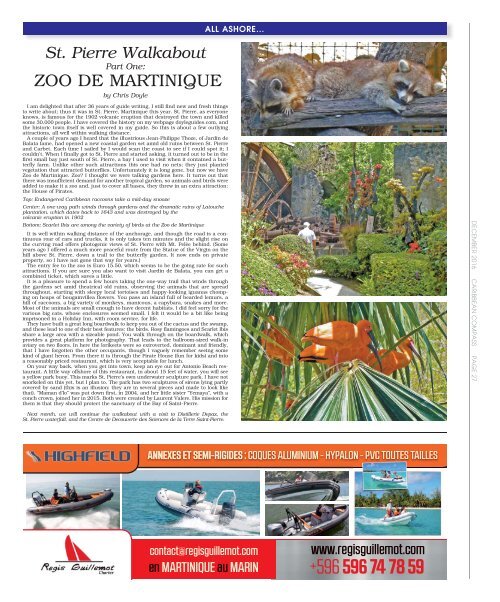Caribbean Compass Yachting Magazine December 2016
Welcome to Caribbean Compass, the most widely-read boating publication in the Caribbean! THE MOST NEWS YOU CAN USE - feature articles on cruising destinations, regattas, environment, events...
Welcome to Caribbean Compass, the most widely-read boating publication in the Caribbean! THE MOST NEWS YOU CAN USE - feature articles on cruising destinations, regattas, environment, events...
You also want an ePaper? Increase the reach of your titles
YUMPU automatically turns print PDFs into web optimized ePapers that Google loves.
St. Pierre Walkabout<br />
Part One:<br />
ZOO DE MARTINIQUE<br />
by Chris Doyle<br />
ALL ASHORE…<br />
I am delighted that after 36 years of guide writing, I still find new and fresh things<br />
to write about; thus it was in St. Pierre, Martinique this year. St. Pierre, as everyone<br />
knows, is famous for the 1902 volcanic eruption that destroyed the town and killed<br />
some 30,000 people. I have covered the history on my webpage doyleguides.com, and<br />
the historic town itself is well covered in my guide. So this is about a few outlying<br />
attractions, all well within walking distance.<br />
A couple of years ago I heard that the illustrious Jean-Philippe Thoze, of Jardin de<br />
Balata fame, had opened a new coastal garden set amid old ruins between St. Pierre<br />
and Carbet. Each time I sailed by I would scan the coast to see if I could spot it; I<br />
couldn’t. When I finally got to St. Pierre and started asking, it turned out to be in the<br />
first small bay just south of St. Pierre, a bay I used to visit when it contained a butterfly<br />
farm. Unlike other such attractions this one had no nets; they just planted<br />
vegetation that attracted butterflies. Unfortunately it is long gone, but now we have<br />
Zoo de Martinique. Zoo? I thought we were talking gardens here. It turns out that<br />
there was insufficient demand for another tropical garden, so animals and birds were<br />
added to make it a zoo and, just to cover all bases, they threw in an extra attraction:<br />
the House of Pirates.<br />
Top: Endangered <strong>Caribbean</strong> raccoons take a mid-day snooze<br />
Center: A one-way path winds through gardens and the dramatic ruins of Latouche<br />
plantation, which dates back to 1643 and was destroyed by the<br />
volcanic eruption in 1902<br />
Bottom: Scarlet Ibis are among the variety of birds at the Zoo de Martinique<br />
It is well within walking distance of the anchorage, and though the road is a continuous<br />
roar of cars and trucks, it is only takes ten minutes and the slight rise on<br />
the curving road offers photogenic views of St. Pierre with Mt. Pelée behind. (Some<br />
years ago I offered a much more peaceful route from the Statue of the Virgin on the<br />
hill above St. Pierre, down a trail to the butterfly garden. It now ends on private<br />
property, so I have not gone that way for years.)<br />
The entry fee to the zoo is Euro 15.50, which seems to be the going rate for such<br />
attractions. If you are sure you also want to visit Jardin de Balata, you can get a<br />
combined ticket, which saves a little.<br />
It is a pleasure to spend a few hours taking the one-way trail that winds through<br />
the gardens set amid theatrical old ruins, observing the animals that are spread<br />
throughout, starting with sleepy local tortoises and happy-looking iguanas chomping<br />
on heaps of bougainvillea flowers. You pass an island full of bearded lemurs, a<br />
hill of raccoons, a big variety of monkeys, manicous, a capybara, snakes and more.<br />
Most of the animals are small enough to have decent habitats. I did feel sorry for the<br />
various big cats, whose enclosures seemed small. I felt it would be a bit like being<br />
imprisoned in a Holiday Inn, with room service, for life.<br />
They have built a great long boardwalk to keep you out of the cactus and the swamp,<br />
and these lead to one of their best features: the birds. Rosy flamingoes and Scarlet Ibis<br />
share a large area with a sizeable pond. You walk through on the boardwalk, which<br />
provides a great platform for photography. That leads to the ballroom-sized walk-in<br />
aviary on two floors. In here the lorikeets were so extroverted, dominant and friendly,<br />
that I have forgotten the other occupants, though I vaguely remember seeing some<br />
kind of giant heron. From there it is through the Pirate House (fun for kids) and into<br />
a reasonably priced restaurant, which is very acceptable for lunch.<br />
On your way back, when you get into town, keep an eye out for Antonio Beach restaurant.<br />
A little way offshore of this restaurant, in about 15 feet of water, you will see<br />
a yellow park buoy. This marks St. Pierre’s own underwater sculpture park. I have not<br />
snorkeled on this yet, but I plan to. The park has two sculptures of sirens lying partly<br />
covered by sand (this is an illusion: they are in several pieces and made to look like<br />
that). “Maman d’lo” was put down first, in 2004, and her little sister “Yemaya”, with a<br />
conch crown, joined her in 2015. Both were created by Laurent Valere. His mission for<br />
them is that they should protect the sanctuary of the Bay of Saint-Pierre.<br />
DECEMBER <strong>2016</strong> CARIBBEAN COMPASS PAGE 27<br />
Next month, we will continue the walkabout with a visit to Distillerie Depaz, the<br />
St. Pierre waterfall, and the Centre de Decouverte des Sciences de la Terre Saint-Pierre.<br />
www.regisguillemot.com<br />
ill +596 596 74 78 59


















